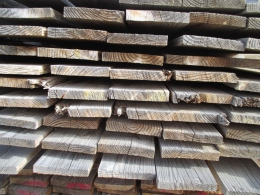
Board lumber is a type of wood that has been processed into beams and planks. There are two main types - either rough-sawn or surfaced on one or more of its faces. Among the more common pieces in construction is the 2x4 and the 4x4, but lumber is sold in many dimensions.
In North America, hardwood lumber is commonly sold based on a "quarter" size system, referring to thickness. 4/4 (four quarter) = to a 1-inch-thick (25 mm) board, 8/4 (eight quarter) is a 2-inch-thick (51 mm) board, etc. The "quarter" system is rarely used for softwood lumber; although softwood decking is sometimes sold as 5/4, though it is one-inch thick.
Dimension lumber is further subdivided into five categories based on size classifications. These classes are structural joists and planks, studs, decking, light framing, and structural light framing. After the dimension lumber has been separated, the grader assigns a grade.
- Structural light framing lumber has nominal dimensions of 2" to 4" thickness and 2" to 4" width, and typically divided into four separate grades: select structural, No. 1, No. 2, and No.3. Select Structural is the best grade in terms of strength characteristics and also the most expensive, No. 1 is the second best, and so on.
- Light framing lumber has nominal dimensions of 2" to 4" thickness and 2" to 4" width and is divided into three separate grades: construction, standard, and utility. Construction is the best in this case.
- Stud lumber has nominal dimensions of 2" to 4" thick and 2" to 6" wide. There is only one grade of stud lumber.
- Decking is divided into two grades: select decking and commercial decking. Select decking is best in this case.
- Structural joists and planks has nominal dimensions of 2" to 4" thickness and 5" or greater width, and are typically divided into four separate grades: select structural, No. 1, No. 2, and No.3.
Timbers are also subdivided into two groups by size classification: Beams and Stringers and Posts and Timbers. Again, after the lumber has been separated, the grader assigns a grade.
- Visual grades of posts and timbers (nominal dimensions of 5" and thicker and width not more than 2" greater than thickness) are dense select structural, Dense No. 1, No. 1, and No. 2. Dense select structural is the best grade in terms of strength characteristics and also the most expensive, No. 1 is the second best and so on.
- Visual grades of beams and stringers (nominal dimensions of 5" and thicker and width more than 2" greater than thickness) are dense select structural, Dense No. 1, No. 1, and No. 2. Dense Select Structural is the best grade in terms of strength characteristics and also the most expensive, No. 1 is the second best and so on.
Board lumber is graded by evaluating the better face of the board. Natural and manufacturing defects are considered, but strength is not a critical factor (unlike the grading of dimension lumber).
- The highest classification of board lumber is called select grade. Select grade is further divided into three categories: B & Better, C Select, and D Select. B is the best but all of the select grades are used in demanding finishing applications.
- The next classification is called common grade. Common grade boards generally contain more knots than the select grade. Common grade is divided numerically from 1 to 5 with 1 being the best in appearance. No. 3 and No. 4 common grades are most frequently used for such applications as sheathing or sub-flooring.
All board lumber can typically be reused as-is for any non-structural application such as stud walls, finishes or furniture. For structural applications the boards would need to either be evaluated by a qualified engineer, or subject to regrading. For boards that are too short, damaged, or otherwise inappropriate for reuse, recycling into woodchips or mulch is available.
Waste to Energy.
boardfeet (bf)
National Lumber Grades Authority
Canadian Lumber Standards Accreditation Board
You have no items in your list.
Click or tap on the My List stars on any business card or profile to add or remove organizations.